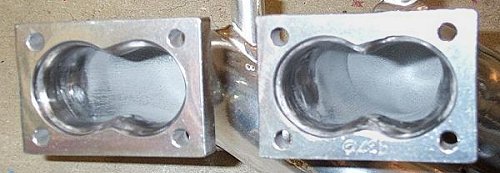
|
|
This exhaust project took a lot of work and money. Did I do it just for fun? Well partially, but the real motivation was to get more power out of the engine. My premise was that the modified 2.5L S14 that I had built was being choked by the two-piece 2.3L Gr A header and more significantly, by the Supersprint center resonator and stock rear muffler. I did not expect huge gains, but I thought that the engine might be happier with a little more breathing room. Note that the pressure tuning of the exhaust system was not changed in any major way. The third Y is still in the same relative place, right where the stock X-Pipe would be. The Borla and Magnaflow mufflers are of a straight through design, and as such they are "seen" by the exhaust as essentially a straight pipe. No pressure effects are introduced. |
|
From the outset I knew that there was some risk of the bottom end of the power band "going soft" with the addition of the Evo III header. That's because the larger diameter secondaries cause the flow to slow down, which in turn reduces the inertia "pull" on the evacuating cylinder. As a consequence, there could be less tendency to pull in fresh charge during the overlap period of the camshaft. However, as RPM's climb, exhaust speed through the header rises, and eventually the larger secondaries start to be a benefit. They allow the outgoing exhaust gasses to keep moving, where a smaller header would start to choke them off. Note that these so called "inertia effects" are separate from pressure tuning. Both mechanisms exist simultaneously, and for the most part are independent of one another. Inertia effects depend on gas velocity, and as such are proportional to tubing diameter. Pressure tuning involves pressure waves traveling at the speed of sound. These waves don't care about tube diameters, they only care about how far they have to travel. Since their speed is essentially constant (neglecting temperature effects) then it is the distance between pressure reflection points that matters to them. A carefully designed header will have taken both inertia tuning and pressure tuning into account to arrive at a balance of peak power and "area under the curve". Below the reader will find a pair of dyno plots which compare the two-piece header w/ SuperSprint center section (and stock muffler) to the Evo III header w/ custom 3" exhaust system. Absolutely no other changes were made to the engine other than the exhaust. Both sets of runs were performed at Dynospot Racing in Mountain View, CA in an effort to reduce any variability between dynamometers. The weather on both occasions was almost identical - roughly 75° F and dry. |
|
Dyno curve for TORQUE w/ new Evo III exhaust. (close window) |
|
Dyno curve for POWER w/ new Evo III exhaust. (close window) |
|
A look at the charts reveals that my initial hypothesis was mostly borne out. The new exhaust did indeed cause a softening of the torque curve at lower rpm's. Sometimes the torque of the Evo III header is the same as before (at the local peaks) and the rest of the time it is generally lower. This continues until about 6000 RPM at which point the new Evo III exhaust starts to wake up. From 6000 RPM on up there is a significant increase in torque, and especially power, with the new exhaust. In fact, with this new exhaust the engine would be quite useable right up to 8000 rpm and maybe even to 8200 rpm. This allows one to hold on to a lower gear longer, which is always good for acceleration. I would have to say that at this point my engine has plenty of exhaust. Further development will have to turn to the intake tract. I would really like to implement a temperature/pressure corrected throttle position engine management system (a.k.a. Alpha-N w/ MAP). Reports are that the removal of the AFM from the intake path generally bumps up the torque curve, starting even at low RPM's. If this turns out to be the case, then the new 3" exhaust and Evo III header may really come into play. |
|
|